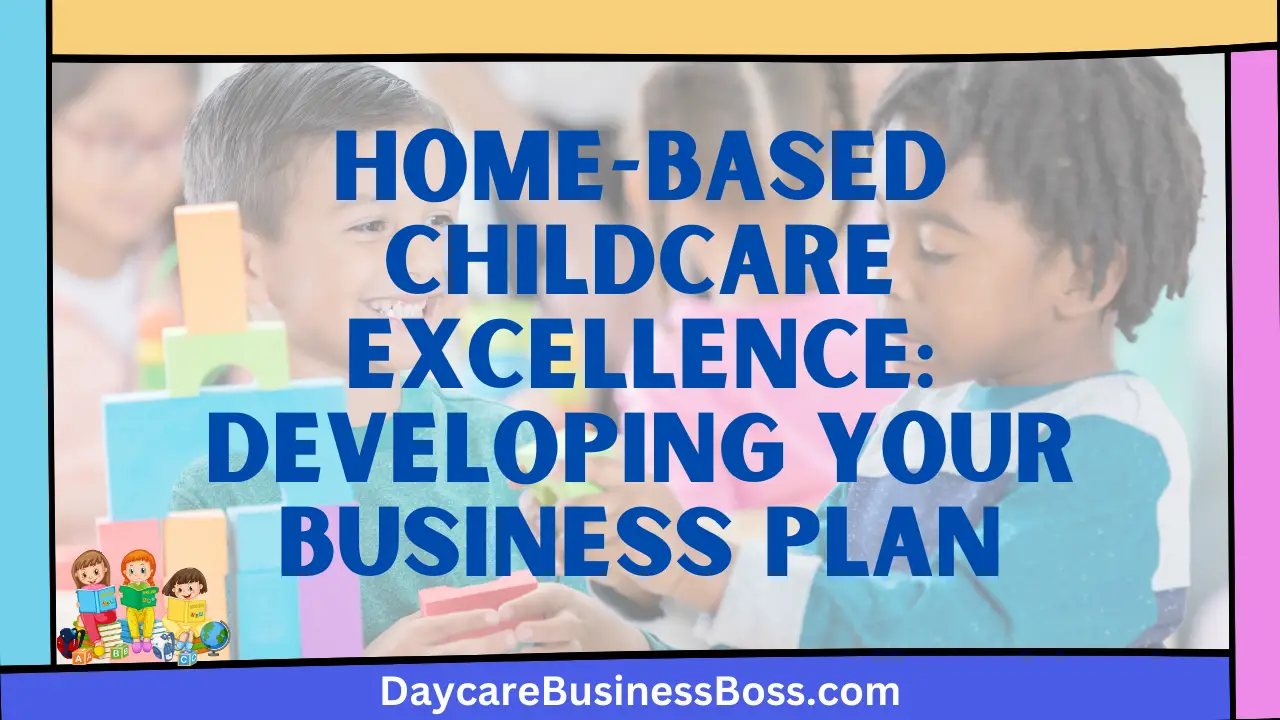Starting a home daycare is a path that combines your passion for caring for children with the world of entrepreneurship. A properly developed company plan stands between your concept and its realization as you enter this fulfilling domain. A well-structured business plan, like a compass, guides a traveler through new territory, paving the way for your home daycare’s growth and profitability.
To create a home daycare business plan, you should outline your services, target market, pricing, operational details, safety protocols, marketing strategies, and financial projections. Highlight your unique selling points and growth plans for a comprehensive and effective plan.
This article delves into the complexities of developing a detailed business plan geared to the specific demands of a home childcare operation. Whether you’re a seasoned childcare expert or a beginner in the sector, the sections that follow will illuminate the route to not only developing a plan but also laying the groundwork for long-term productivity in the realm of home daycare.
Services and Vision
Begin your business strategy by explicitly describing the services you hope to deliver through your daycare operation. This includes defining the precise age groups you wish to serve, outlining the full curriculum you intend to execute, and outlining any extra offers such as nutritional meals or convenient transportation.
Beyond these practical elements, however, it is critical to build a crystal-clear vision that underpins the core soul of your childcare business. This all-encompassing vision should include not just your daycare’s primary objective, but also the basic values that will be woven into the fabric of every aspect of your organization. Expressing your preferred educational style, whether play-based, Montessori, or another pedagogical philosophy, can help to define the distinct educational environment your daycare aims to build.
This fundamental underpinning not only serves as a roadmap for your company’s activities, but also conveys a feeling of consistency and purpose to potential stakeholders, investors, and parents. By highlighting the services, age groups, curriculum, and supplemental amenities, you create a powerful and persuasive framework for the entire business plan that follows.
Target Market Analysis
Identifying your target market is a critical step in developing an informed business plan. This means diving into the complex world of the parents and families you hope to help with your products. A multidimensional strategy entails not only studying the demographics of your potential clientele but also being aware of the geographical place in which your venture operates.
However, this isn’t just a numbers game; it’s about instinctively understanding your prospective clients’ core requirements and objectives. This involves a thorough examination of their tastes, desires, and even the difficulties they experience. This allows you to identify the exact pain locations that your services are best suited to treat.
With this comprehensive insight in hand, your next step is to expertly design your services to meet the specific needs of your target market. This strategic alignment guarantees that your products are in sync with their goals, generating a deeper connection between your enterprise and its intended beneficiaries.
By painstakingly identifying your target market and examining their demographics, geography, and unique demands, you not only create tremendous empathy for your clients, but you also lay the framework for a business model that lives on individualized solutions. This thorough understanding of your customers will be the foundation of your company’s growth, influencing everything from marketing efforts to the overall user experience you provide.
Pricing Strategy
Building a well-calibrated pricing structure needs a thorough examination of numerous essential elements. Among these is a thorough examination of your operating expenses, including both direct and indirect costs. This careful assessment enables you to establish a baseline figure that not only covers your expenses but also establishes a platform for profitability.
Concurrently, analyzing the pricing tactics of competitors in your niche gives a useful standard for comparison. You can gain insights into industry norms and adapt your price to remain competitive and appealing by placing your charges within the context of the market landscape.
Nonetheless, when developing your pricing tiers, it is critical to capture the value proposition inherent in your services. By emphasizing the specific benefits your daycare provides, you may attach a value that goes beyond expenditures, allowing you to justify premium pricing if necessary.
A difficult balance must be struck between keeping your services affordable to parents and maintaining the viability of your business. By threading this needle, you understand the financial restraints that parents may encounter while also ensuring the sustainability and quality of your venture.
Transparency is essential: systematically define your pricing tiers, revealing the unique features and benefits each level provides. If your approach includes discounts, bundles, or special packages, make sure that potential clients are aware of them.
Operational Details

It is critical to paint a comprehensive image of your daycare’s everyday operations to ensure clarity and confidence among potential stakeholders. Begin by describing your facility’s spatial layout and how it has been meticulously constructed to meet the requirements and safety of the children. This contains areas for play, rest, and any specialized learning zones.
Outline the personnel requirements that are essential to the operation of your daycare. Define your staff members’ tasks and responsibilities, including everything from child supervision and involvement to hygiene and meal preparation. This ensures a thorough awareness of the team dynamics that will guide the day’s activities.
A well-organized timetable is the foundation of every daycare’s operational rhythm. Create a detailed timetable that covers all aspects of a day, from arrival to departure. This plan should include a well-balanced mix of structured activities, free play, meals, and rest periods. A well-balanced schedule not only promotes a favorable learning environment but also guarantees parents their child’s overall well-being.
It is critical to address the regulatory framework that governs the functioning of your daycare. Describe the precise licensing and regulatory requirements imposed by your local government. This transparency demonstrates your dedication to following the law, reinforcing confidence and credibility among potential clients.
To ensure compliance, painstakingly detail how your daycare meets these criteria, including everything from safety regulations to staff-to-child ratios. By demonstrating your daycare’s compliance with legal and regulatory requirements, you create trust in parents and stakeholders alike, demonstrating your commitment to the welfare and development of the children in your care.
Read more about: Crafting a Strategic Blueprint: The Key Elements of a Home Daycare Business Plan
Safety Protocols
It is non-negotiable to prioritize safety inside the daycare ecosystem. Extend the complete list of safety precautions you intend to implement, leaving no stone untouched. Outline careful childproofing measures that include everything from fastening electrical outlets to assuring furniture stability, reducing potential hazards, and establishing a safe environment that encourages discovery and learning.
Communicate rigorous health and hygiene practices that go beyond conventional cleanliness, addressing every facet of keeping a germ-free environment. This includes cleanliness measures, regular handwashing routines, and tight guidelines for handling food and personal things, ensuring parents that their child’s well-being is taken seriously.
Include a clear emergency response blueprint that outlines step-by-step procedures for a variety of unforeseeable events. Cover fire drills, medical emergencies, and evacuation plans to demonstrate your ability to manage any emergency with calm and efficiently.
Highlight the extensive training your personnel will receive to strengthen their capacity to provide a safe environment. CPR and first aid certifications, as well as crisis management training, demonstrate the dedication to a team that is ready to protect every kid in their care.
Marketing Strategies
A captivating marketing campaign is essential for recruiting a large clientele base to your daycare enterprise. To effectively reach your target audience, articulate a multidimensional approach that smoothly mixes online and offline techniques. Describe your internet strategies, which could include a professionally created website with detailed information about your daycare’s offerings, philosophy, and safety precautions. Highlight the strategic use of social media channels to engage parents through informative material, engaging images, and direct engagement.
Offline activities should also be highlighted, including the distribution of visually stunning and informative leaflets that capture the soul of your daycare. Form local alliances with schools, community centers, and family-owned companies to increase mutual exposure and trust.
Explain how you propose to market your unique selling features (USPs) to differentiate your daycare from competitors. Highlight these differentiators throughout your marketing materials, whether it’s a precisely planned curriculum, customized attention, or novel learning approaches. These USPs create the foundation of your identity, appealing to parents looking for different benefits for their children.
Financial Projections
Offering a practical financial forecast is critical in demonstrating your full understanding of the complex financial variables that control the daycare operation. Begin by outlining the early startup costs, which should include anything from facility improvements and equipment purchases to licensing fees and employee training expenses. This clear communication emphasizes your rigorous planning and resource allocation.
Extend this foresight to include continuous operational expenses, including staffing wages, utilities, supplies, and maintenance. By methodically estimating these regular outlays, you present a comprehensive picture of your venture’s financial viability.
Include a contingency aspect that represents your understanding of the unpredictability of business. This buffer ensures that unforeseen events do not affect your financial balance, assuring stakeholders of your risk management prudence.
However, it is not only about money. Provide revenue predictions based on thorough market research and a thorough understanding of your pricing structure. These forecasts should take into account your expected enrollment numbers, pricing levels, and any other revenue streams, such as supplementary services or after-school programs.
Unique Selling Points (USPs)
Enhancing your daycare’s uniqueness is critical to attracting the attention of parents looking for a superior educational environment for their children. Highlight the features that set your establishment distinct from the crowd. Whether it’s a trailblazing curriculum that seamlessly integrates play-based learning with cutting-edge technology, a team of seasoned educators brimming with expertise and enthusiasm, or a strategic and easily accessible location that caters to the convenience of parents’ daily routines – these are your unique selling points (USPs) that resonate with discerning parents.
If your operation hours are flexible enough to accommodate modern families’ schedules, or if you provide extra help through after-school programs, emphasize these features. Each USP adds a layer of value that demonstrates your dedication to providing more than the ordinary.
Growth Plans

Envisioning the long-term trajectory of your daycare’s growth demonstrates your commitment to its long-term productivity. Create a long-term vision that goes beyond the present, including plans for expansion and evolution. Extend prospective development opportunities, such as creating new branches in different communities or perhaps expanding into adjacent educational domains.
Describe any additional services you intend to introduce in response to changing demand. Adding specialized enrichment programs, summer camps, or parent workshops to your service portfolio broadens your service portfolio and caters to a larger range of needs.
Take a forward-thinking approach by considering how your daycare will remain nimble in the face of changing market trends. Discuss technology breakthroughs and altering educational paradigms, highlighting your dedication to constantly updating your curriculum and teaching approaches to fit with the most recent pedagogical advances.
Read more about: From Plans to Caring Hands: Kickstarting Your Elderly Daycare
Executive Summary
The executive summary is a brief description of the key parts of our childcare business plan, intended to provide potential investors and partners with a full understanding of our vision.
Our childcare philosophy is based on providing a safe, exciting, and supportive environment for the holistic development of children. We assure an exciting educational journey by providing a professionally developed curriculum, experienced staff, and cutting-edge facilities.
Our target market includes parents looking for high-quality early childhood education in a convenient urban setting. Our pricing plan strikes a compromise between affordability for parents and the long-term viability of our endeavor.
Our financial projections show constant development while paying close attention to initial setup costs, operational expenses, and revenue expectations. These estimates demonstrate our dedication to budgetary restraint and profitability.
Looking ahead, we see opportunities for growth through new branches and the introduction of supplemental services that are in line with emerging trends. Our forward-thinking strategy demonstrates our commitment to remaining a relevant and influential player in the ever-changing daycare industry.
Frequently Asked Questions

What is the purpose of a business plan for my home daycare?
A business plan acts as a road map for the efficacy of your daycare. It includes information on your services, target market, price, safety precautions, marketing plans, and financial projections. This thorough paper assists you in staying organized, obtaining money, attracting clients, and making informed decisions.
What is the best pricing plan for my home daycare?
Your price approach should strike a mix between parent affordability and long-term profitability. Consider operating costs, competitive pricing, local market trends, and the distinct value you provide. Make certain that your pricing covers your expenses while remaining competitive in your target market.
What should my daycare’s unique selling points (USPs) be?
Your unique selling points set you to distinguish yourself from the competition. They could include your specific curriculum, skilled staff, flexible hours, convenient location, one-of-a-kind activities, or any other innovative childcare method. Highlight what makes your daycare unique and why parents should pick you to care for and develop their children.
To learn more on how to start your own daycare checkout my startup documents here.
The information provided by DaycareBusinessBoss.com (“The Site”) is for general informational purposes only. All information on the Site is provided in good faith, however, we make no representation or warranty of any kind, express or implied, regarding the accuracy, adequacy, validity, reliability, availability or completeness of any information on the Site. Under no circumstance shall we have any liability to you for any loss or damage of any kind incurred as a result of the use of the Site or Reliance on any information provided on the Site. Your use of the Site and your reliance on any information on the Site is solely at your own risk.
This blog post is for educational purposes only and does not constitute legal advice. Please consult a legal expert to address your specific needs. Terms and Conditions. (https://daycarebusinessboss.com/terms-conditions/)

Meet Shawn Chun: Entrepreneur and Childcare Business Fan.
I’m a happy individual who happens to be an entrepreneur. I have owned several types of businesses in my life from a coffee shop to an import and export business to an online review business plus a few more and now I create online daycare business resources for those interested in starting new ventures. It’s demanding work but I love it. I do it for those passionate about their business and their goals. That’s why when I meet a childcare business owner, I see myself. I know how hard the struggle is to retain clients, find good employees and keep the business growing all while trying to stay competitive.
That’s why I created Daycare Business Boss: I want to help childcare business owners like you build a thriving business that brings you endless joy and supports your ideal lifestyle.

